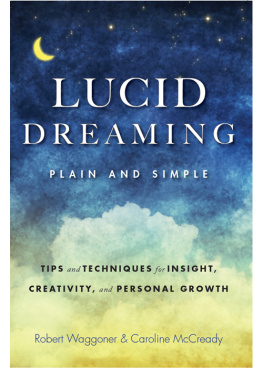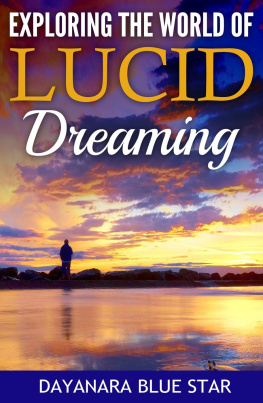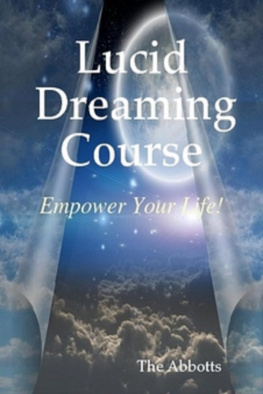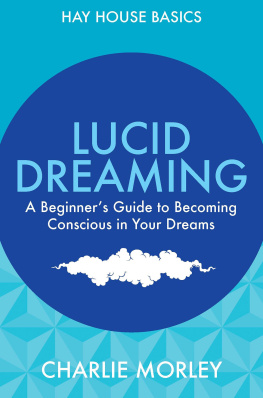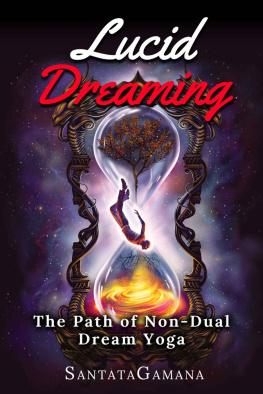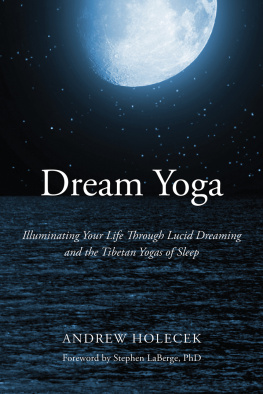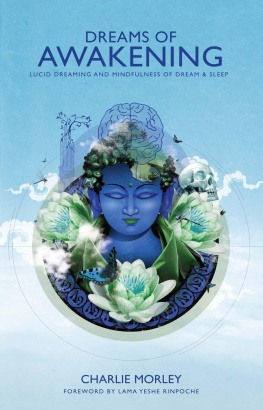
First published in 2015 by Conari Press, an imprint of
Red Wheel/Weiser, LLC
With offices at:
665 Third Street, Suite 400
San Francisco, CA 94107
www.redwheelweiser.com
Copyright 2015 by Robert Waggoner and Caroline McCready
All rights reserved. No part of this publication may be reproduced or transmitted in any form or by any means, electronic or mechanical, including photocopying, recording, or by any information storage and retrieval system, without permission in writing from Red Wheel/Weiser, LLC. Reviewers may quote brief passages.
ISBN: 978-1-57324-641-5
Library of Congress Cataloging-in-Publication Data available upon request.
Cover design by Jim Warner
Interior by Frame25 Productions
Typeset in Adobe Garamond Pro
Printed in Canada.
MAR
10 9 8 7 6 5 4 3 2 1
www.redwheelweiser.com
www.redwheelweiser.com/newsletter
CONTENTS
ACKNOWLEDGMENTS
We wish to acknowledge and thank the many lucid dreamers, researchers, and others who provided helpful insights, lucid dreams, and editing for this book. Their contributions have made this a much richer and deeper exploration of lucid dreaming.
Although Cicero cautioned that it is difficult to remember all and ungracious to omit any, we want to mention specifically the following lucid dreamers for their assistance and support: Don Middendorf, Ph.D.; Ed Kellogg, Ph.D.; Clare Johnson, Ph.D.; Lucy Gillis; Maria Isabel Pita; Beverly D'Urso, Ph.D.; Charlie Morley; Ian Burke; Caz Coronel; Tereza Griffin; John D. Cooper; Dr. Rory Mac Sweeney; Olga Richterova; Mary Ziemer; Joy Fatooh; Kristin E. LaMarca, Ph.D.; Line Salvesen; Robert J. Hoss; Dr. Scott Sparrow; David L. Kahn; Kelly Frappier; PasQuale Ourtane; Justina Lasley; Nigel Hamilton, Ph.D.; Linda Mastrangelo; Melanie Schdlich; Jeffrey Peck, Mark Hettmannczyk; Daniel Love; Jane Ahring; Rebecca Turner; Ryan Hurd; and various unnamed others.
We also wish to thank the researchers who continue to explore and support research efforts in lucid dreaming. The extraordinary efforts of pioneers like Keith Hearne, Ph.D.; Alan Worsley; and Stephen LaBerge, Ph.D., have laid a strong foundation for current researchers and assisted countless lucid dreamers.
Special thanks to artist and lucid dreamer Dustyn Lucas for allowing us to include an image of his painting, The Mirage of Duality in the Sands of Time, which he originally saw in a lucid dream. To see more of his work, visit his website at www.dustynlucas.com. Also thanks to Justina Lasley for allowing us to excerpt a dream interpretation technique from her book, Honoring the Dream. We very much appreciate the use of written excerpts by Ed Kellogg and author Maria Isabel Pita. The insights of Ed Kellogg on healing in lucid dreams and the phenomenology of this state have given us a broader and wiser view. Finally, we send our deep thanks to Don Middendorf and Jeffrey Peck for reviewing and improving the final manuscript.
Sincere thanks to our many friends and colleagues who supported and encouraged us in this process. In particular, Robert wishes to thank the International Association for the Study of Dreams and its members, who provide a welcoming and thoughtful place to explore the depths of dreaming and the lucid dream experience. In addition, he thanks his family and his wife, Wendy, for all of their support and encouragement.
Caroline wishes to thank all the people who come to her lucid dreaming groups and workshops in London. She also thanks Charlie Morley, whose lucid dreaming forums have been an ongoing source of encouragement and inspiration, and Debbie Winterbourne for her insight and help in creating a community of lucid dreamers in London. Caroline extends a very special thank you for the endless support from her treasured family and beautiful friends, especially her parents and brother, and Tereza, Zakia, Emma, Caz, and Hannah.
A portion of the authors' royalties from this book are being donated to www.replanttrees.org.
PREFACE
In 1975, I taught myself how to lucid dream (or realize I was dreaming while in the dream state) and have logged more than 1,000 lucid dreams since that time. Because my first book, Lucid Dreaming: Gateway to the Inner Self, explores the incredible experience and potential of lucid dreaming, many people have asked for a simple how-to book on inducing, stabilizing, and working within lucid dreams.
A few years ago in London, I met a talented artist, speaker, and lucid dreamer named Caroline McCready, who agreed to join me in creating a guidebook on lucid dreaming to assist others on this path. Having another set of experiences and insights, like Caroline's, has done much to enhance the depth and richness of this guide, particularly in .
In this book, we have sought to provide the necessary tools for you to have lucid dreams and investigate this extraordinary state firsthand. Here, along with instructions distilled from many years of personal experience, you will find valuable insights and techniques from our lucid dreaming colleagues and friends.
Please focus on this guide carefully and do not rush through it, because, when you realize you are dreaming and become lucidly aware, you will need to recall and apply these tips and techniques.
Lucid dreaming exists as a mentally dynamic state and often reflects back to us our beliefs, assumptions, feelings, and expectations. As you venture into lucid dreaming more deeply, you will realize that the exploration encourages you to examine certain beliefs and assumptions more critically. In fact, you may come to experience another type of education through lucid dreamingan education in the nature of the mind and perceived experience that calls forth insights capable of transforming yourself and your waking life.
As an introduction to lucid dreaming, this book does not address many advanced topics, including cultural assumptions about the nature and meaning of dreaming and lucid dreaming. In future books by us and others, we hope these areas and assumptions will receive more attention and investigation.
Best wishes on your journey of awareness,
Robert Waggoner and Caroline McCready
January 2014
INTRODUCTION
To understand lucid dreaming more clearly, it often helps to have others tell their stories of how they were introduced to the idea of becoming consciously aware of dreaming while in the dream state. Here in the Introduction, coauthor Caroline McCready and I recount our own discovery of lucid dreaming's depth and a bit about the lessons we learned.
Caroline's Experience
I can still remember my first lucid dream vividly. As the dream begins, I am in a small room playing a game of pool with my cousin when I suddenly realized that I was dreaming. As soon as I realized it was a dream, I felt astounded. Knowing that I was actually inside a dream was mind-blowing. Everything felt so real. When I ran my fingertips over the green felt on the table, it felt realistically soft and fibrous. The pool balls felt so convincingly solid and smooth. They made very real clinking sounds as they hit one another. I remember stopping and becoming very still, just wanting to take it all in, in complete wonder. Then I woke up.
I started to glimpse the potential of lucid dreaming when I became lucid for a second time. In this next dream, I found myself playing by a swing in a very accurate replica of my real garden. Something triggered my lucidity and led me to an exciting lucid dream. In waking life, I had recently watched the first Superman film with Christopher Reeve. In my dream, I suddenly recalled the scene in which he takes Lois Lane flying. Lucidly aware, I thought to myself that that would be amazing! No sooner had I thought this than a dream version of Superman, in his blue-and-red caped suit, came swooping in and flew me up above my garden. I remember looking down as my swing became smaller and smaller and my garden became increasingly distant. It felt so exhilarating!
Next page
